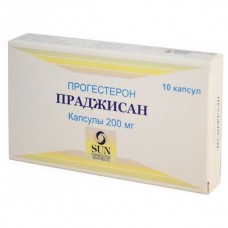Expiration date: 05/2026
Release form, composition and packing:
Soft gelatin capsule, oval, pale yellow in color, the contents of capsules - oily suspension almost white.
1 capsule contains 100 mg of progesterone
Excipients: peanut butter - 147.5 mg, soy lecithin - 2.5 mg.
The composition of the capsule shell: sorbitol 70% solution (uncrystallized) - 9 mg, glycerol - 44.89 mg, gelatin - 85.5 mg of titanium dioxide - 1.06 mg, purified water - 84.55 mg.
Soft gelatin capsule, oval, pale yellow in color, the contents of capsules - oily suspension almost white.
1 capsule contains 200 mg of progesterone
Excipient: peanut oil - 295 mg Soy lecithin - 5 mg.
The composition of the capsule shell: sorbitol 70% solution (uncrystallized) - 12.8 mg glycerol - 63.84 mg, gelatin - 121.60 mg, titanium dioxide - 1.50 mg, purified water - 120.26 mg.
Pharmachologic effect:
Progestogen hormone of the corpus luteum. By binding to receptors on the surface of cells of target organs, it enters the nucleus, where it activates DNA promotes RNA synthesis. Promotes transition mucous membrane of the uterus phase proliferation, called follicular hormone in the secretory phase, and after fertilization - in the condition necessary for the development of a fertilized egg. Reduces muscle excitability and contractility of the uterus and fallopian tubes, it stimulates the development of breast terminal elements.
Stimulating proteinlipazu increases fat reserves, increases glucose utilization by increasing the concentration of basal and stimulated insulin contributes to the accumulation in the liver glycogen, increases aldosterone production: in small doses accelerates, and in large - inhibits the production of gonadotropic pituitary hormones reduces azotemia, increases the excretion of nitrogen urine. It activates the growth of secretory department of acini of the mammary glands and induces lactation. It promotes the development of normal endometrium.
Pharmacokinetics:
If ingestion
Suction
Micronized progesterone is well absorbed in the gastrointestinal tract. progesterone plasma concentration gradually increases during the first hour, Cmax observed after 1-3 h after administration.
Metabolism
It is metabolized in the liver with the participation of isoenzyme CYP 2C19. The major metabolites are determined in plasma are 20-alpha-hydroxy-delta-4-alpha-pregnanolon and 5-alpha dihydroprogesterone.
breeding
Excreted in the urine as metabolites. 95% of them are glyukuronkonyugirovannye metabolites, mostly 3-alpha, 5-beta-pregnanediol (pregnandion). These metabolites are determined in plasma and urine are similar to the substances formed at physiological secretions of the corpus luteum.
Vaginal administration
Suction
Absorption occurs quickly, progesterone is stored in the uterus, the high concentration of progesterone in blood plasma observed 1 hour after administration. Cmax progesterone plasma levels achieved in 2-6 hours after administration. When administered the drug with 100 mg of 3 average concentration is maintained for 24 hours. When administered at doses of 200 mg / I concentration of progesterone corresponds trimester of pregnancy.
Metabolism
Predominantly metabolized to form 3-alpha, 5-beta-pregnanediol. Concentration of the 5-beta-pregnanediol is not increased in the plasma.
breeding
Return with urine in the form of metabolites, the main part is 3-alpha, 5-beta-pregnandiol (pregnandion).
Indications Pragisan drug capsules:
Disorders related to progesterone deficiency.
The oral route of administration:
- Infertility due to luteal insufficiency,
- premenstrual syndrome,
- Menstrual disorders due to violations of ovulation or anovulation,
- Fibrocystic breast disease,
- Premenopausal,
- Hormone replacement therapy of peri- and postmenopausal (in conjunction with estrogensoderjath drugs).
The vaginal route of administration:
- Hormone replacement therapy in the case of progesterone deficiency when dormant (absent) ovaries (egg donation)
- Support of the luteal phase in preparation for the
in vitro fertilization,
- Support of the luteal phase in a spontaneous or induced menstrual cycle,
- Premature menopause,
- Hormone replacement therapy (in combination with estrogen drugs)
- Infertility due to luteal insufficiency,
- Prevention of habitual abortion and threatened due to lack of progestin,
- Prevention of uterine fibroids,
- Prevention of endometriosis.
Dosage and administration:
The duration of treatment depends on the nature and characteristics of the disease.
The oral route of administration
The drug is taken orally with water.
In most cases, the daily dose of progesterone deficiency Pragisan 200-300 mg of the drug is divided into 2 doses (morning and evening).
In luteal phase insufficiency (premenstrual syndrome, fibrocystic breast disease, dysmenorrhea, premenopausal) daily dose is 200 or 400 mg taken within 10 days (usually 17 to 26-day cycle).
With hormone replacement therapy in peri- and postmenopausal women while taking estrogen drug used Pragisan 200 mg / within 10-12 days.
The vaginal route of administration
Capsules are injected deep into the vagina.
Absolute progesterone deficiency in women with non-functioning (absent) ovaries (egg donation) on the background of estrogen therapy on 200 mg / 13 and 14th days of the cycle, followed by 100 mg 2 from 15 th to 25 th day of the cycle, with 26th day, in the case of establishing pregnancy dose increases to 100 mg / every week, reaching a maximum of 600 mg / divided into 3 doses. This dose can be used for 60 days.
Support of the luteal phase in preparation for in vitro fertilization: It is recommended to take 200 to 600 mg / starting from the day of injection of human chorionic gonadotropin for I and II trimesters of pregnancy.
Support of the luteal phase in a spontaneous or induced menstrual cycle, infertility associated with impaired function of the corpus luteum is recommended to take 200-300 mg / starting from the 17th day of the cycle for 10 days, in the case of menstruation and pregnancy diagnosis, treatment should be continued .
In cases of threats to abortion or for prevention of habitual abortions occurring against a background of progesterone deficiency: 200-400 mg daily in 2 divided doses in I and II trimesters of pregnancy.
Side effect:
For oral administration route
Bleeding "breakthrough" or shortening the normal menstrual cycle, breast tension (usually during the first month of treatment).
Drowsiness, dizziness, transient (usually within 1-3 h after administration), and nausea. These side effects can be reduced by lowering the dose of the drug regime change or transition to the vaginal route of administration. These effects are usually the first signs of overdose.
The feeling of fatigue, migraine, headache, skin rash, itching, jaundice, fluid retention.
For oral and vaginal routes of administration
Allergic reactions (urticaria, anaphylactic shock).
Contraindications to the use of the drug capsules Pragisan:
For oral and vaginal administration
- Thrombophlebitis, thromboembolic disorders, intracranial
bleeding or having a history of these conditions,
- Bleeding from the genital tract of unknown origin,
- Incomplete abortion,
- Porphyria
- Established or suspected malignancy of breast or genital organs,
- Hypersensitivity to the drug, including to peanut oil, soybean.
For oral application (optional)
- Severe liver disease is currently (including cholestatic jaundice, hepatitis, hepatocellular carcinoma, Dubin-Johnson syndrome, Rotor) or history, if liver function tests have not returned to normal.
Precautions should be prescribed the drug for diseases of the cardiovascular system, hypertension, chronic renal failure, diabetes, asthma, epilepsy, migraine, depression, hyperlipoproteinemia.
Use of the drug Pragisan capsules during pregnancy and lactation:
Use of the drug during pregnancy is not contraindicated. Nevertheless, there is a potential risk to the fetus (especially male) upon application of progesterone in the first 4 months of pregnancy. The use of micronized progesterone in II-III trimesters of pregnancy can lead to the development of liver disease in pregnant women. Numerous epidemiological studies have found no cases of fetal abnormalities when using progesterone in pregnancy.
Progesterone enters the breast milk. Data on the use of the drug during lactation is not sufficient to assess the potential risk to the baby.
Application for violations of liver function:
Oral administration is contraindicated in severe liver disease is currently (including cholestatic jaundice, hepatitis, hepatocellular carcinoma, Dubin-Johnson syndrome, Rotor) or history, if liver function tests have not returned to normal.
Application for violations of renal function:
Precautions should be prescribed the drug in patients with chronic renal failure.
Special instructions:
The drug should not be used for contraception.
With long-term treatment of progesterone necessary to conduct medical examinations (including liver function tests), treatment should be discontinued if there are deviations of diagnostic tests of liver function or occurrence of cholestatic jaundice. In the application of estrogen and / or progestogen-containing preparations have been cases of chloasma, especially in patients with a history of chloasma during previous pregnancy. Women with a tendency to develop chloasma, skin exposure to natural or artificial UV radiation can cause or exacerbate chloasma.
It is necessary to monitor patients with a history of depression, and in the case of severe depression, it is necessary to cancel the drug. Patients with underlying cardiovascular disease or the presence of their history should also be observed periodically by your doctor.
In the treatment of progesterone may experience fluid retention, which can affect the course of epilepsy, migraine, asthma, cardiac or renal insufficiency, such patients should be monitored closely.
Effects on ability to drive vehicles and management mechanisms
When taken orally, you must be careful when driving vehicles and occupation of other potentially hazardous activities that require high concentration and psychomotor speed reactions.
Overdose:
Symptoms: drowsiness, transient dizziness, shortening of the normal menstrual cycle.
Treatment: dose reduction or correction of the reception mode, for example, in the case of drowsiness and dizziness - 200 mg taken at night from the 12th to the 14th day of the cycle or go on vaginal route of administration: in the case of shortening of the menstrual cycle - start treatment later in the cycle such as from the 19th day, 17th instead. If necessary, symptomatic treatment.
Drug Interactions:
For oral use:
Prolonged simultaneous use of barbiturates, carbamazepine, hydantoin and rifampicin may reduce the effectiveness of progesterone.
Despite the limited data, it is supposed that the activated carbon and griseofulvin can also reduce the efficacy of the drug.
Progesterone can increase the therapeutic, pharmacological or toxic effects of cyclosporine, theophylline, and troleandomycin.
Vaginal application:
Interaction in intravaginal application have not been assessed. Avoid simultaneous administration of other intravaginal drugs in order to avoid violations of the release and absorption of progesterone.
Conditions and terms:
The drug should be stored in dry, dark, place inaccessible to children at temperature not above 25 ° C. Shelf life - 2 years.



